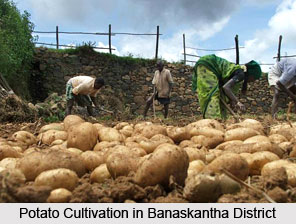Economy of Banaskantha District of Gujarat is chiefly dependent on agro and food processing, tourism, textile and mineral based industries. The district ranks first in the production of vegetables contributing nearly 17.67 percent to the total vegetable production of the State. It is the largest producer of Potatoes and one of the leading producers of Isabgul (Psyllium husk) in the country. Traditionally, the district is known for its food processing industry, especially for vegetable oils and Vanaspati.
Banaskantha district is the third largest producer of oil seeds in the State after Junagadh and Jamnagar. Bajra, Maize, Tobacco, Castor oil, Jowar, Psyllium and Potatoes are the other major crops of the district. Deesa Taluka in the Banaskantha district ranks first in India for the production of Potatoes. The district ranks next to Junagadh and Rajkot in the production of Spices. The other spices produced in the district are Isabgul, Fennel, Fenugreek and Cumin and important vegetables produced in the district are Cow Pea, Beans, Tomato, Brinjal and Cabbage.
 Banaskantha district has rich mineral reserves including limestone, marble, granite, building stone and china clay. Banaskantha district accounts for almost the entire marble reserves of the State of Gujarat. Danta Taluka of Banaskantha district is known for its high quality marble production. Major Medium and Large Scale Industries (MSI & LSI) industries in Banaskantha district are engaged in the production of granite tiles and marble blocks. The district has seven SSI clusters focused on textile (spinning and weaving of cotton textiles and khadi), diamond processing, and ceramics industry (processed Stone, marble). Out of these industrial clusters, three of the SSI clusters are located in the Palanpur taluka, two are located in Vadgam and one each is located in Danta and Deesa talukas.
Banaskantha district has rich mineral reserves including limestone, marble, granite, building stone and china clay. Banaskantha district accounts for almost the entire marble reserves of the State of Gujarat. Danta Taluka of Banaskantha district is known for its high quality marble production. Major Medium and Large Scale Industries (MSI & LSI) industries in Banaskantha district are engaged in the production of granite tiles and marble blocks. The district has seven SSI clusters focused on textile (spinning and weaving of cotton textiles and khadi), diamond processing, and ceramics industry (processed Stone, marble). Out of these industrial clusters, three of the SSI clusters are located in the Palanpur taluka, two are located in Vadgam and one each is located in Danta and Deesa talukas.
The textile clusters located in Palanpur and Vadgam talukas together consists of 397 units (109 in spinning and weaving of cotton textiles and 286 units in khadi manufacturing). The diamond processing cluster in Palanpur and Deesa consists of 104 units. The district has witnessed highest investment in agro and food processing over a period of two decades. Engineering has emerged as the third highest investment aggregator in the district over two decades. Mineral Based (ceramic and cement) along with sugar industry have also emerged as preferred sectors for investment in Banaskantha district. Tourist inflow also contributes to a large extent to the economy of the district.
Proposed Delhi Mumbai Industrial Corridor (DMIC) passing through the Diamond Hub - Palanpur is expected to emerge as the major economic driver of the district. The vast reserves of marble in the district are a great potential for ceramic industry. Various support infrastructure projects planned across the proposed DMIC are expected to further boost the economic growth of the region due to the improved intra and inter State connectivity of the district.






